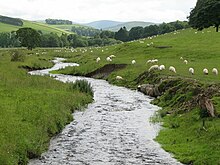River in Scottish Borders, Scotland
| Eddleston Water | |
|---|---|
 | |
| Nickname(s) | The Cuddy |
| Location | |
| Country | Scotland |
| Council area | Scottish Borders |
| Settlements | Eddleston, Redscarhead and Peebles |
| Physical characteristics | |
| Source | Howgate |
| • location | Herbertshaw Farm |
| • coordinates | 55°48′06″N 003°11′25″W / 55.80167°N 3.19028°W / 55.80167; -3.19028 |
| Mouth | River Tweed |
| • location | Peebles |
| • coordinates | 55°39′03″N 003°11′43″W / 55.65083°N 3.19528°W / 55.65083; -3.19528 |
| Basin size | 69 km (27 sq mi) |
| Basin features | |
| Progression | River Tweed→ Solway Firth→ Irish Sea |
| River system | Solway Tweed |
| Tributaries | |
| • left | Longcote Burn |
| • right |
|

Eddleston Water is a small river north of Peebles, in the Scottish Borders area of Scotland which joins the River Tweed at Peebles. It is also known locally as "The Cuddy".
Course
Eddleston Water rises near Mount Lothian and passes through Waterheads, Eddleston, Milkieston, Redscarhead, along the route of the A703, and into Peebles past crossburn, and Dalatho, where the Tree Bridge, on an old drove road, and the Cuddy Bridge (just by brown brothers and squeaks old bit) cross it. The original bridge was constructed in the 15th century but was replaced in 1857 by the current bridge.
When the Edinburgh to Peebles railway was built in the middle of the 19th century the river was straightened for much of its course which adversely affected the wildlife habitat and increased the speed of flow. As a result, the river is liable to flooding.
Flood management
In August 2009 the University of Dundee was invited to carry out an initial study on how Eddleston Water could be restored to provide a better habitat for wildlife and to reduces the risk of flooding in Peebles and Eddleston. Known as natural flood management (NFM) it involves re-meandering, tree planting and other measures, including "leaky dams" where logs are placed across a stream in such a way that the normal flow passes under but, as the water rises, the logs slow the passage of the water. This has been shown to be more effective at reducing flooding than the introduction of bends though the latter has led to an increase of biodiversity along the river.
See also
- Darnhall Mains
- List of places in the Scottish Borders
- List of places in Scotland
- List of rivers of Scotland
References
- Peebles - Undiscovered Scotland
- "Royal Borough of Peebles - Peebles attractions". Archived from the original on 16 September 2008. Retrieved 10 May 2010.
- RCAHMS/Canmore record of Eddleston Water
- "Peebles, Cuddy Bridge". Canmore. Retrieved 24 November 2023.
- ^ "Scottish Borders Council publication: "Improving the Eddleston Water for People and Wildlife"" (PDF). Archived from the original (PDF) on 6 June 2011. Retrieved 7 May 2010.
- SCRAN image: Eddleston Water bursts its banks
- Murugesu, Jason Arunn (3 June 2023). "How a UK river serves as a natural lab for flood research". New Scientist. 258 (3441): 12.
This Scottish Borders location article is a stub. You can help Misplaced Pages by expanding it. |
This article related to a river in Scotland is a stub. You can help Misplaced Pages by expanding it. |